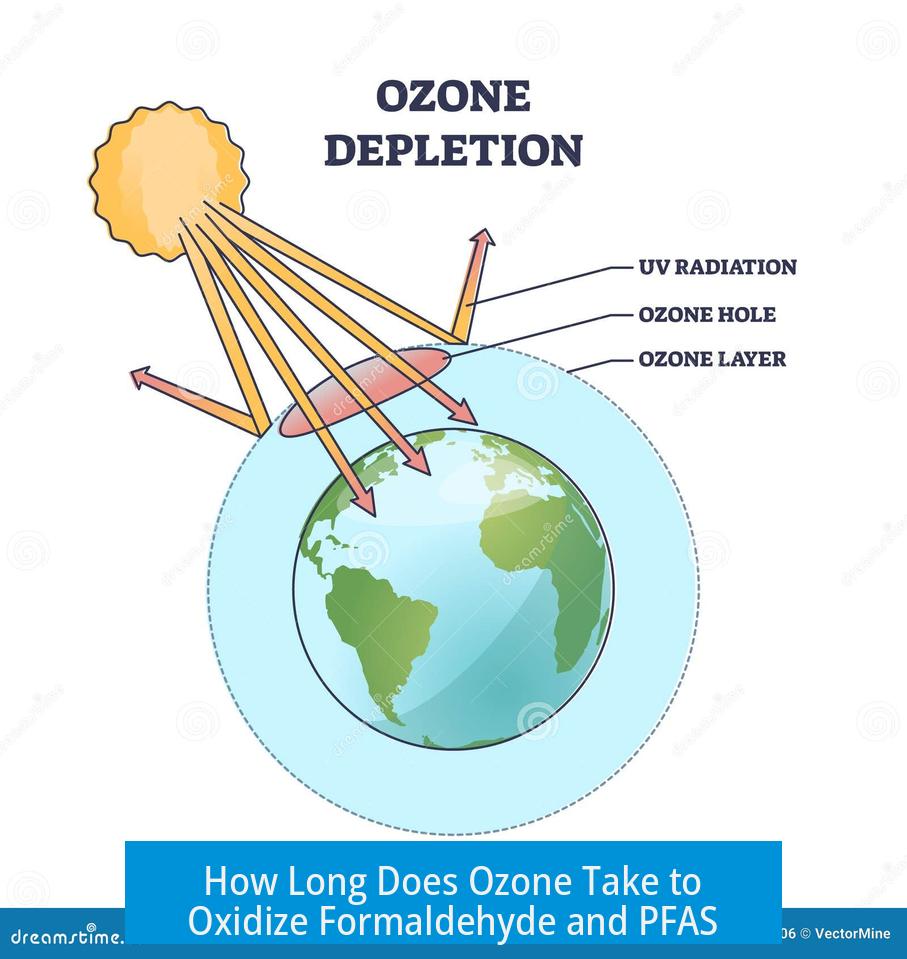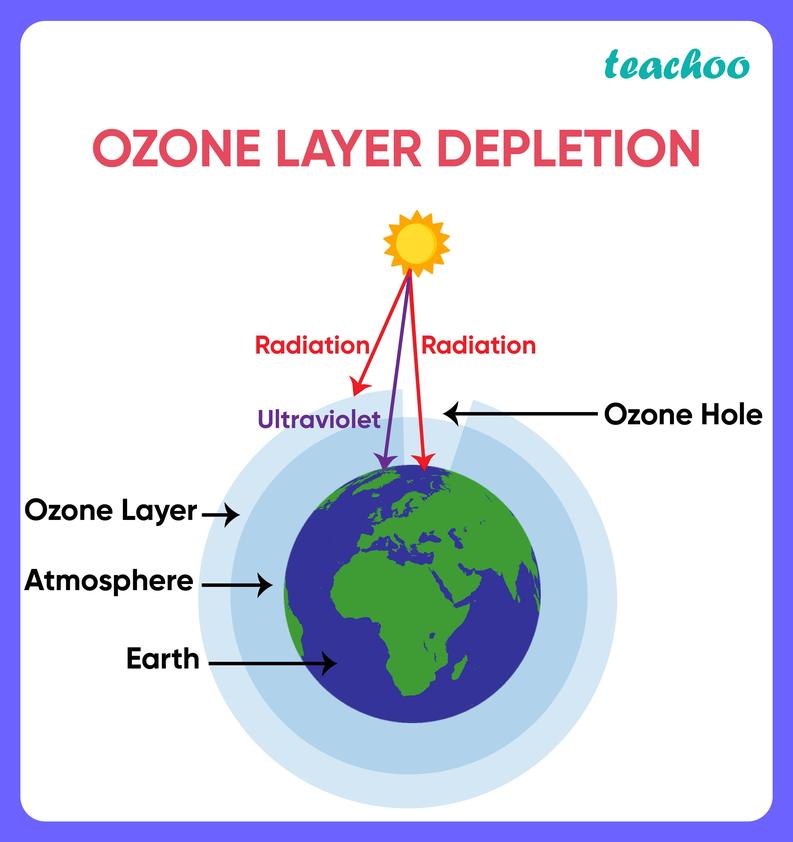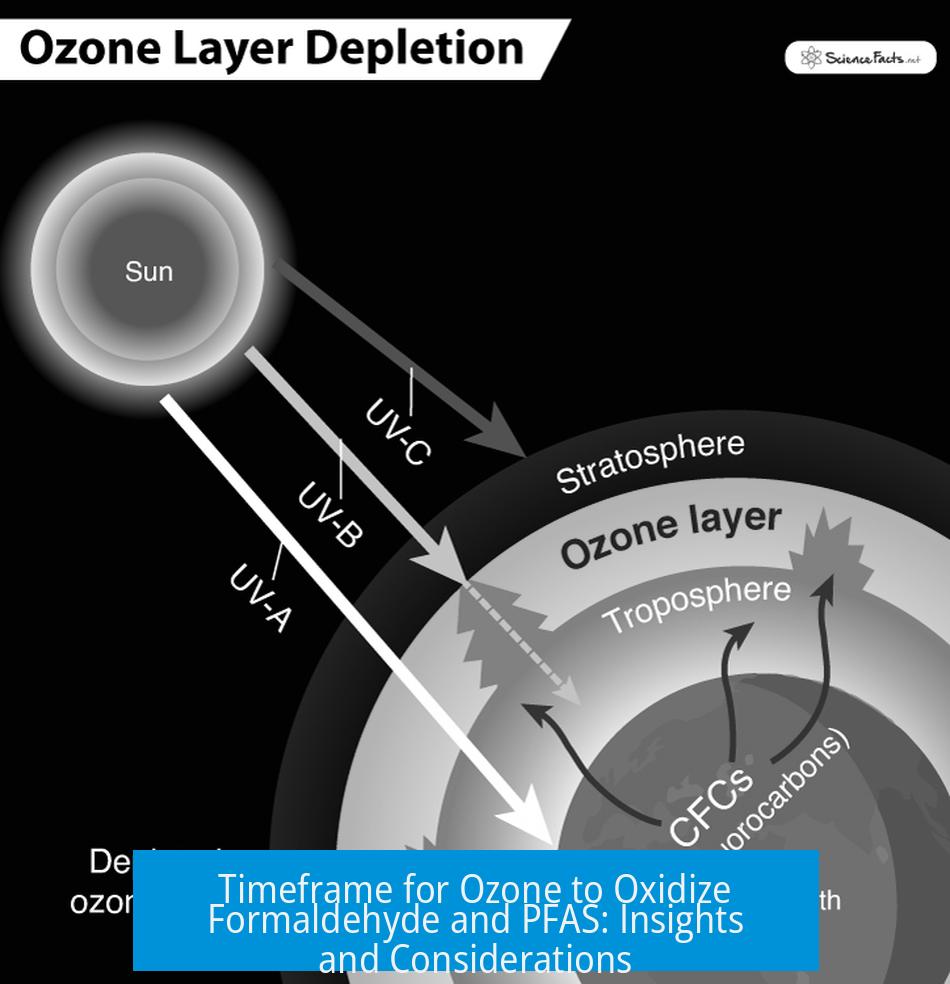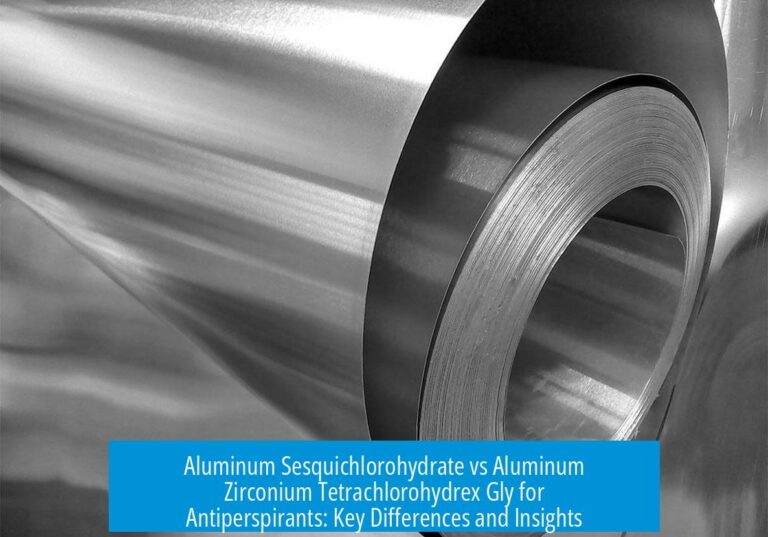How Long Does Ozone Take to Oxidize Formaldehyde and PFAS?

Ozone does not effectively oxidize PFAS and is unnecessary for formaldehyde removal; washing quickly and safely removes formaldehyde, while PFAS resists oxidation by ozone under any conditions.
Ozone and PFAS: Resistance to Oxidation

PFAS (per- and polyfluoroalkyl substances) are synthetic chemicals characterized by strong carbon-fluorine bonds. These bonds confer exceptional chemical stability, making PFAS resistant to most oxidative agents, including ozone.
- Ozone, a powerful oxidant, fails to degrade PFAS effectively.
- Attempts to oxidize PFAS with ozone do not result in significant breakdown or mineralization.
- Industrial and environmental reports confirm ozone’s inefficacy against PFAS even after prolonged exposure.
The chemical design of PFAS prevents ozone from breaking the stable carbon-fluorine bonds necessary to degrade these compounds.
Ozone and Formaldehyde: Removal Efficiency

Formaldehyde is a small, water-soluble organic molecule widely used in various applications. Due to its high solubility and reactivity, formaldehyde is easily removed from surfaces and fabrics by washing with water.
- Standard laundry washing effectively removes formaldehyde within minutes to an hour.
- Ozone treatment is unnecessary for formaldehyde removal because its solubility favors direct removal rather than oxidation.
- Ozone may be used in some industrial applications for volatile organic compound oxidation, but not recommended for household or textile formaldehyde removal.
Safety Considerations of Ozone Use

While ozone can oxidize many contaminants, it is hazardous and can worsen indoor air conditions if used improperly.
- Ozone exposure may create toxic byproducts and lingering odors.
- Use of ozone generators for cleaning without professional control risks health and safety.
- Ozone can create unpleasant plasticky smells that are hard to remove.
Summary on Time and Effectiveness

| Substance | Effectiveness of Ozone | Time Frame | Recommended Method |
|---|---|---|---|
| PFAS | Ineffective | Not applicable | Avoid ozone; use specialized treatments |
| Formaldehyde | Unnecessary | Minutes (via washing) | Simple water washing |
No precise ozone oxidation time is documented for these chemicals. Washing removes formaldehyde rapidly. PFAS degradation by ozone does not occur in practical timeframes.
Key Takeaways
- Ozone cannot oxidize PFAS; these compounds resist breakdown.
- Formaldehyde is removed quickly by washing, making ozone redundant.
- Ozone use poses risks including harmful residues and odors.
- Washing is the safest, most effective method for formaldehyde removal.
- Avoid attempting ozone treatment for PFAS or household formaldehyde without expert guidance.
How Long Would It Take Ozone to Oxidize Formaldehyde and PFAS?
Ever wondered how long it actually takes ozone to oxidize stubborn chemicals like formaldehyde and PFAS? Let’s cut to the chase: ozone doesn’t realistically oxidize PFAS at all, and formaldehyde is better off being washed away, not ozonated. Clear enough? Now, let’s peel this apart with facts, a sprinkle of caution, and some practical wisdom.
First Up: The Enigma of PFAS and Ozone
PFAS, or those pesky polyfluoroalkyl substances, have built a reputation. They’re tough. Super tough. These compounds laugh in the face of most chemical agents.
Think of PFAS as the chemical equivalent of the indestructible Terminator. Ozone, despite being a powerful oxidizer, simply can’t break them down. Multiple experts confirm that ozone does little to nothing in destroying PFAS. So how long does it take? The answer: it doesn’t. Not under normal or even extreme conditions.
Why? PFAS are engineered to resist chemical attack. Their strong carbon-fluorine bonds form a barrier that ozone can’t breach. Whether ozone exposure lasts minutes, hours, or days, the PFAS molecules remain largely unaffected.
Formaldehyde: The Easygoing Opponent
Now, formaldehyde is another story. This one is a bit of a diva—but an easily tamed diva. Unlike PFAS, formaldehyde loves water. It’s highly soluble and quite reactive, which ironically makes it easier to get rid of.
Experts agree: washing with water alone removes formaldehyde efficiently. Just throw that laundry in a standard wash cycle, and voilà, formaldehyde levels plummet swiftly. So, how long would ozone take to oxidize formaldehyde? The question is almost moot.
Using ozone here isn’t just overkill; it’s potentially dangerous. Ozone creates a plasticky smell that lingers, trading one problem for another. In short, washing beats ozonation without a contest.
The Risky Business of Ozone Use
Before you rush to buy an ozone generator to “cleanse” your home or your contaminated items, think twice. Ozone is a double-edged sword. It’s an aggressive oxidizer, sure, but it’s also hazardous.
Wrong use of ozone can turn your living space into a hazardous zone. That plastic odor it leaves behind? Just the tip of the iceberg. It can worsen indoor air quality, irritate your respiratory system, and cause even more trouble than it solves.
Imagine curing one foul smell but getting replaced by an equally persistent, synthetic “new car” stench you can’t shake off. Yep, ozone can do that. And with chemicals like PFAS, it does nothing meaningful while risking your safety.
So, How Long Does Ozone Take?
| Substance | Ozone Oxidation Time | Effectiveness | Recommended Action |
|---|---|---|---|
| PFAS | Indeterminate / Ineffective | None under normal conditions | Avoid ozone; rely on other methods (e.g., advanced filtration) |
| Formaldehyde | Not applicable / unnecessary | Highly soluble in water; easy to remove by washing | Wash with water; avoid ozone due to risk |
There is no credible timeline for ozone breaking down PFAS because it just doesn’t happen. As for formaldehyde, the answer is: a standard washing cycle (usually under an hour) will clear it out far better and safer than ozone treatment could hope to achieve.
Practical Tips and Recommendations
- If you’re dealing with formaldehyde on fabric, fresh air and a machine wash are your best friends.
- For PFAS contamination, don’t waste time chasing ozone miracles. Instead, consider advanced filtration or professional chemical treatment methods designed specifically for PFAS.
- Avoid DIY ozone generators. Unless you are a certified expert, DIY ozonation can cause health hazards.
- Focus your efforts where they count: washing for water-soluble toxins, and specialized methods for resistant compounds like PFAS.
Why This Matters Now More Than Ever
PFAS contamination is a growing concern due to their persistence in the environment and potential health risks. Formaldehyde, commonly found in household products, is often a surface-level issue easily dealt with—if you know how.
So why risk all in hopes that ozone will work? It won’t for PFAS and it’s an unnecessarily dangerous approach for formaldehyde. Clean smarter, not harder.
Final Thought: Don’t Jump From the Pan Into the Fire
“Ozone is quite dangerous itself, so you may be jumping from the pan into the fire if you don’t know what you are doing… it can make your living space literally uninhabitable.”
This statement sums up the takeaway perfectly. When it comes to oxidizing formaldehyde, stick with tried-and-true washing methods. When it comes to PFAS, it’s best to accept that ozone won’t be your hero. Instead, use expert-recommended approaches and avoid potential indoor air disasters.
How long does ozone take? For PFAS: don’t wait—it won’t happen. For formaldehyde: forget it, water wipes it out neatly in under an hour.
How long does it take ozone to oxidize PFAS?
Ozone does not effectively oxidize PFAS. PFAS are highly resistant to ozone and many other chemical agents, so no practical oxidation time exists for breaking down PFAS with ozone.
Can ozone quickly remove formaldehyde?
Ozone is not recommended for formaldehyde removal. Formaldehyde dissolves and reacts easily in water, so simple washing removes it quickly, usually within one laundry cycle.
Why is ozone not advised for oxidizing formaldehyde or PFAS?
Ozone is hazardous and can create harmful indoor air conditions. It may cause persistent odors and worsen air quality. Using ozone for these chemicals without expert knowledge is risky and unnecessary.
Is there a known timeframe for ozone to oxidize formaldehyde?
No specific time frame exists because ozone use is impractical. Washing with water removes formaldehyde effectively and much faster than any ozone treatment could.
What is the best method to remove formaldehyde from fabrics?
Washing with water is the best and fastest way. Formaldehyde is water soluble and reactive, so a normal wash cycle will remove it completely without needing ozone.





Leave a Comment